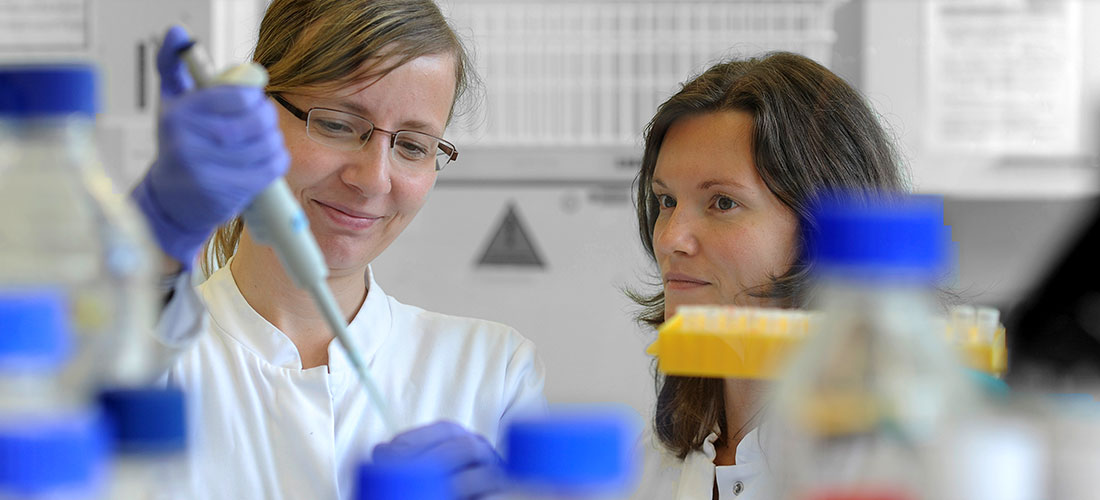Prof. Dr. rer. nat. Achim Leutz

Cell Differentiation and Tumorigenesis
Head of the International PhD Program
Max Delbrück Center for Molecular Medicine (MDC)
Robert-Rössle-Str. 10
13092 Berlin
Tel: +49 30 9406 3735
E-Mail: aleutz(at)mdc-berlin.de
https://www.mdc-berlin.de/leutz
University Education
- 1976-1982 University of Heidelberg
- 1982 Exam, Thesis, Neurobiology
- 1982-1986 PhD at EMBL, Dr. rer. nat., University of Heidelberg
Professional Experience (selection)
- 1986-1988 SUNY at Stony Brook, NY, U.S.A., post-doctoral research, EMBO fellow
- 1990-1994 Research Group Leader, ZMBH, University of Heidelberg
- 1994- Research Group Leader, MDC; since 2004 Univ.-Prof. Humboldt-Univ. Inst. of Biology
Scientific Scope
C/EBP in differentiation and tumorigenesis
CCAAT/enhancer binding proteins (C/EBP) are “pioneering transcription factors” that regulate cell fate in combination with lineage restricted factors, such as Myb, PU.1, Runx, or PPARγ. Deregulation of C/EBPα,β in the mouse results in many diseases, including defects in hematopoiesis, immunity, energy metabolism, regener¬ation, female reproduction, and behavior. Both, C/EBPα,β have been linked to human tumorigenesis through de-regulation of the Rb/Cyclin/¬E2F/¬SWI/SNF network and C/EBPα gene mutations are prevalent in myeloid leukemia.
We are interested in how pioneering C/EBP transcription factors may toggle between so many different functions. Experimental and bio-infor¬matics evidence suggests that the multi-functionality of C/EBPs is based on epigenetic context and the unusual structural plasticity and abundant post-transcriptional regulation: Highly conserved regions (CR) in C/EBPα,β are connected by intervening “low complexity regions” (LCRs) that are intrinsically unfolded. The modular structure represents a “beads on a string”-type arrangement that may engage in numerous inter-and intra-molecular inter¬actions. Signaling mediated tailor-made C/EBP isoforms are generated by alternative translation initiation and by extensive decoration with dozens of post-translational modifi¬cations (PTM). The modifications play key roles in orches-trating interaction with epigenetic co-factor complexes and the transcriptional machinery.
We employ mass spectrometry, proteomics, biochemical/molecular genetic analysis, recom-bi¬nant mouse biology, and TALen mediated gene deletion in human cell lines to un¬ravel the many facets of C/EBP in the realm of epigenetic/gene regulatory mechanisms and physio-logical interconnectivity. We have identified many epigenetic modifiers that together with the multitude of PTMs and the structural plasticity of C/EBP navi¬gate and consolidate gene expression and cell fate. We antici¬pate that unraveling the PTM-dependent C/EBP protein interaction net¬work will help to elucidate how C/EBP are involved in diverse settings such as proliferation / differentiation control, hematopoiesis, and tumorigenesis.
Most important Awards, Grants or Scientific Achievements
- 2005 Appointment, EMBO Member
- 2007 German Cancer Award
Selected References
- Kowenz-Leutz, E. and Leutz, A. (1999) A C/EBP-beta Isoform Recruits the SWI/SNF Complex to Activate Myeloid Genes” Molecular Cell, 4:735-743
- Mo X., Kowenz-Leutz E., Xu H., and Leutz A. (2004) Ras Induces Mediator Complex Exchange on C/EBPbeta. Molecular Cell, 13:241-250
- Mo, X., Kowenz-Leutz, E., Laumonnier, Y., Xu, H., and Leutz, A. (2005) Histone H3-tail positioning and acetylation by c-Myb but not the v-Myb DNA binding SANT Domain. Genes & Development, 19: 2447-2457
- Pless, O., Kowenz-Leutz, E., Knoblich, M., Lausen, J., Beyermann, M., Walsh, M. J., Leutz, A. (2008) G9a-mediated lysine methylation alters the function of CCAAT/enhancer-binding protein-beta. J. Biol. Chem., 283: 26357-26363
- Smink, J.J, Bégay,V., Schoenmaker, T., Sterneck, E., de Vries, T.J., and Leutz, A. (2009) Transcription factor C/EBPβ isoform ratio regulates osteoclastogenesis through MafB. The EMBO J., 28: 1769-1781
- Wethmar, K Bégay V., Wiesenthal, V. Zaragoza, K. Dörken, B., Calkhoven C.F and Leutz, A. (2010) C/EBPDuORF mice – a mammalian model for uORF-mediated translational control. Genes & Development, 24:15-20
- Kowenz-Leutz, E., Pless, O., Dittmar, G., Knoblich, M., and Leutz, A. (2010) Crosstalk between C/EBPβ phosphorylation, arginine methylation, and interaction with SWI/SNF and Mediator complexes implies an indexing code during gene regulation. The EMBO J, 29:1105-1115
- Zaragoza, K., Bégay, V., and Leutz, A. (2010) Transcriptional repression of C/EBPα by E2F-DP complexes. Molecular and Cellular Biology, 30:2293-2304
- Leutz, A., Pless, O., Lappe, M., Dittmar, G., Kowenz-Leutz, E. (2011) Crosstalk between phosphorylation and multi-site arginine/lysine methylation in C/EBPs. Transcription, 2:1-6
- Pless, O., Kowenz-Leutz, E., Dittmar, G., and Leutz, A. (2011) A differential proteome screening system for post-translational modification-dependent C/EBP interactions.



